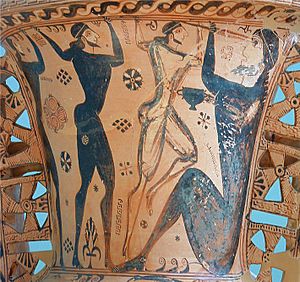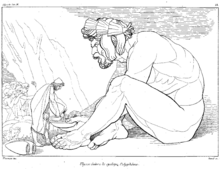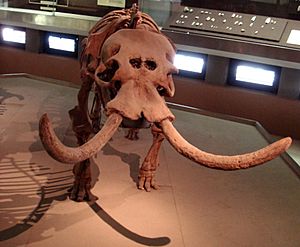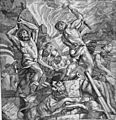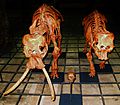Cyclops facts for kids
A Cyclops is a mythical giant from Greek mythology. They are famous for having only one large eye in the middle of their forehead. The name "Cyclops" means "round eye." There were two main groups of Cyclopes in ancient stories.
Contents
First Generation of Cyclopes
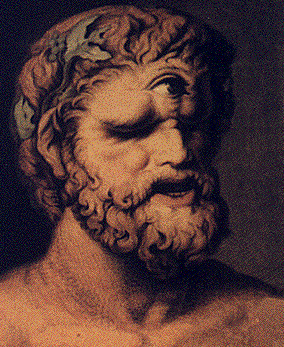
These first Cyclopes were powerful giants. They were the children of Uranus (the sky god) and Gaia (Mother Earth). They had one eye and were known for being very strong and a bit grumpy. According to the ancient writer Hesiod, they were tough and quick to show their feelings. Their names became symbols of great strength and power. People used their names to describe really well-made weapons.
There were three of these Cyclopes: Brontes, Steropes, and Arges. Uranus was afraid of their strength. So, he locked them away in Tartarus, a deep part of the underworld. Later, Cronus, another son of Uranus and Gaia, set the Cyclopes free. He also freed the Hecatonchires and Gigantes.
The Cyclopes then helped Zeus in a big war. They created powerful lightning bolts for Zeus to use as a weapon. With their help, Zeus was able to overthrow Cronus and the other Titans. Each Cyclops added something special to Zeus's thunderbolts:
- Arges made them bright.
- Brontes added the sound of thunder.
- Steropes gave them the lightning flash.
These skilled Cyclopes also made other famous items for the gods:
- Poseidon's powerful trident.
- Artemis's bow and arrow.
- The helmet that Hades gave to Perseus for his quest to kill Medusa.
They were also helpers of Hephaestus, the god of blacksmiths. People believed the Cyclopes built the strong walls of ancient cities like Tiryns and Mycenae in Greece. The loud noises from inside volcanoes were thought to be the sounds of the Cyclopes working.
Later stories say that Apollo killed these Cyclopes. He did this after Zeus used a lightning bolt (made by the Cyclopes) to kill Apollo's son, Asclepius.
Second Generation of Cyclopes
Polyphemus
One of the most famous Cyclopes is Polyphemus. His story is told in Homer's epic poem, the Odyssey. The hero Odysseus and his crew landed on the Island of the Cyclopes. They found a large cave and went inside. They started eating some food they found there. They did not know that the cave belonged to Polyphemus.
Polyphemus soon returned and trapped Odysseus and his men inside. He began to eat some of Odysseus's crew members. But Odysseus was very clever and came up with a plan to escape.
To make Polyphemus less careful, Odysseus gave him a barrel of very strong wine. When Polyphemus asked for Odysseus's name, Odysseus told him it was 'Outis'. This Greek word means 'no man' or 'no one'. After drinking the wine, the giant fell asleep. Odysseus and his men then took a sharpened spear and blinded Polyphemus's only eye.
Polyphemus cried out for help. But when other Cyclopes on the island asked what was wrong, he said, "No man has blinded me!" So, they ignored his cries.
The next morning, Odysseus tied his men and himself to the undersides of Polyphemus's sheep. When the Cyclops let his sheep out to graze, the men were carried out safely. Since Polyphemus was blind, he could only feel the tops of his sheep to make sure no one was riding them. As Odysseus sailed away, he shouted his real name. He also declared his victory, which made Poseidon (Polyphemus's father) very angry.
What Does "Cyclops" Mean?
The word "Cyclops" comes from two Greek words:
- cyclos, which means "circle"
- ops, which means "eye"
So, it literally means "circle eye" or "round eye."
Where Did the Stories Come From?
Scholars have a few ideas about how the legend of the Cyclopes began:
- Blacksmiths: Some believe the stories came from ancient blacksmiths. Blacksmiths often wore an eyepatch over one eye. This protected them from sparks and kept them from becoming blind in both eyes. Blacksmiths also sometimes tattooed themselves with circles to honor the sun. This could be another source for the one-eyed giant idea.
- Elephant Skulls: Another idea is that ancient Greeks found skulls of prehistoric elephants. These elephants were much smaller than modern ones. Some of these skulls still exist today on the island of Crete. The large hole in the center of the skull, where the elephant's trunk would have been, might have looked like a single, huge eye socket to people who had never seen a living elephant. The actual eye sockets are on the sides and are much smaller.
"Cyclopean" Walls
After a period called the "Dark Age," the ancient Greeks were amazed by the huge stone blocks used in the buildings of the earlier Mycenaean civilization. Sites like Mycenae, Tiryns, and places on Cyprus had these massive walls. The Greeks thought that only the Cyclopes could have built such huge structures. They believed the Cyclopes had both the skill and the incredible strength needed for such monumental building. That's why these ancient walls are called "Cyclopean" walls.
Images for kids
-
"The Forge of the Cyclopes", a Dutch 16th-century print after a painting by Titian
See also
 In Spanish: Cíclope para niños
In Spanish: Cíclope para niños



